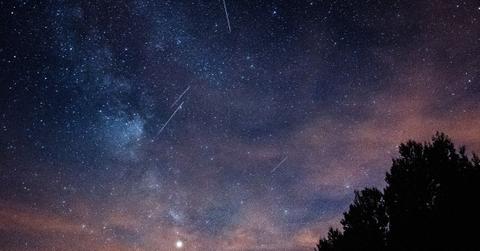How To Catch the Fast Moving Eta Aquarid Meteor Shower
Those living in the Southern hemisphere will be in for a treat with this meteor shower.
Published May 7 2025, 9:09 a.m. ET

Calling all stargazers: You're going to want to mark your calendars for the return of the annual Eta Aquarid meteor shower. This quick moving meteor shower is an especially impressive one that involves meteors that blow through the Earth's atmosphere at a rate of more than 40 miles per second.
These meteors are offshoots of the comet 1P Halley, which is arguably one of the most famous comets around.
And while you need to wait until 2061 to catch sight of Halley's comet again, you can take in the show left behind by her meteors every year.
Sound intriguing? You can find out where to watch the Eta Aquarid meteor shower below.

Where can you watch the Eta Aquarid meteor shower?
The Eta Aquarid meteor shower is visible from both the Southern and Northern hemispheres, according to NASA. That being said, the space agency says that those living in the Southern half of the world will have a much better chance at seeing the Eta Aquarids. That's partially because the Northern Hemisphere sees far fewer meteors — only about 10 meteors are viewable per hour here — due to the location of the radiant visible at these latitudes.
But, just because you'll see fewer of the meteors it doesn't mean you shouldn't look skyward to take in the show. According to NASA, the best location to do so is in a dimly lit area that is far from the light pollution of larger cities.
Once you arrive at a location like this, NASA says you can lay down on the ground (preferably on a sleeping bag or blanket) with your feet pointing east, and look directly up at the sky.
When can you view the Eta Aquarids meteor shower?
According to NASA, it can take up to 30 minutes for your eyes to adjust, so you'll want to make sure you're in position well ahead of the start of the show. That means heading outside during the predawn hours anytime between April 20 to May 21, 2025, as this is when the annual Eta Aquarid is expected to run in 2025.
While these meteors can be viewable for the duration of this time period, stargazers are more likely to get the best view of the shower during its peak.
The Eta Aquarid meteor shower will peak during the predawn hours between May 5-6, 2025, giving night owls and early birds alike a chance to catch the show, which can feature up to 50 meteors an hour.
Missed the peak? Don't worry, the meteors will remain visible for the rest of the season, just at smaller rates.
Where did the Eta Aquarids meteor shower come from?
As we mentioned, the comet of origin for these meteors is Halley's Comet. But according to Space.com, this shower owes its name to the Aquarius constellation. Even though that is not where these meteors originate from, it's where their radiant appears.
But, experts warn that you shouldn't look directly at the constellation if you're hoping to see the meteors, since they can appear throughout the night sky.